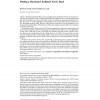77 search results - page 7 / 16 » Reconstructing Phylogenetic Networks Using Maximum Parsimony |
IPPS
2007
IEEE
14 years 9 days ago
2007
IEEE
Bayesian phylogenetic inference is an important alternative to maximum likelihood-based phylogenetic method. However, inferring large trees using the Bayesian approach is computat...
RSA
2010
13 years 4 months ago
2010
We demonstrate the use of computational phylogenetic techniques to solve a central problem in inferential network monitoring. More precisely, we design a novel algorithm for multi...
JCB
2006
13 years 6 months ago
2006
We describe a novel method for efficient reconstruction of phylogenetic trees, based on sequences of whole genomes or proteomes, whose lengths may greatly vary. The core of our me...
JACM
2006
13 years 6 months ago
2006
Abstract. Maximum likelihood (ML) is an increasingly popular optimality criterion for selecting evolutionary trees [Felsenstein 1981]. Finding optimal ML trees appears to be a very...
PROCEDIA
2010
13 years 23 days ago
2010
The field of bioinformatics is witnessing a rapid and overwhelming accumulation of molecular sequence data, predominantly driven by novel wet-lab sequencing techniques. This trend...

